High Visibility Standards for Australian Workwear
When it comes to Australian high visibility standards, it is important to understand the legislative requirements and how and when they apply. As employers, it is your responsibility to ensure the safety of your workers, and that includes their protective workwear. Just because they are wearing a fluorescent orange shirt, doesn't mean they are compliant!
Every Australian construction site must – by law – have a hi-vis policy to ensure items are worn correctly and that workers understand why garments will be ineffective if not worn correctly and at the appropriate time. The business owner or employer provides the workwear required for workers on-site. It is also illegal for people on a construction site to refuse to wear hi-vis clothing and PPE. Construction site managers may also require any subcontractors to wear specific PPE. Site entry signs are posted at the front gate of a construction providing an overview of entry conditions for the site.
What's Covered In This Article...
When Is Hi-vis Required?
The Standards Explained
Workwear Standards
Flame Resistant Standards
Maintaining Compliance of Hi-vis Workwear
Identifying Non Compliant Hi-Vis Clothing
Which Colour Is Best – Yellow or Orange?
How Often Should Workwear Be Replaced?
Taping Configuration in Hi Vis Workwear
Branding Hi-Visibility Safety Garments
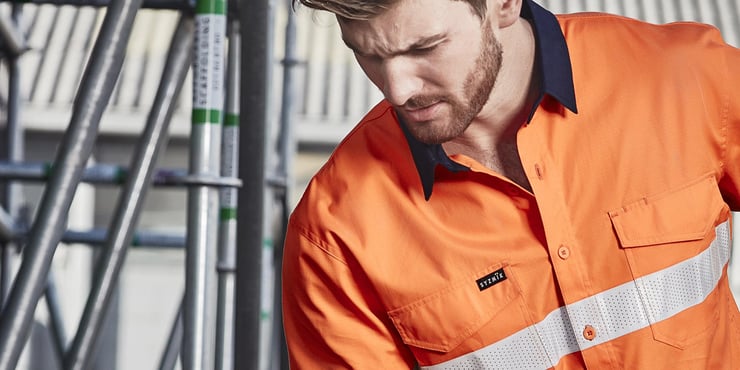
When Is Hi-vis Required?
Hi-vis workwear is commonly used by trades people and labourers in the construction industry or industrial work sites such as warehouses, factories, traffic management or mine sites. Because of its reflective properties, hi-vis clothing reduces the risk of accidents in busy areas where there’s regular traffic or hazardous materials. Light and visibility will dictate whether the requirement to wear full body hi-vis clothing or just on the upper body.
The Standards Explained
The first standard specifies the visual requirements for high-visibility safety garments and covers garments suitable for daytime and night-time wear, or for wear under both conditions. The second standard has requirements with regard to colours, the fluorescent materials and the retroreflective strips. The ONLY colours in the standard are Orange-red, Yellow, Red, Orange and Yellow (restricted).

Workwear Standards
|
Class D — a garment designed for outdoor daytime use only, comprising fluorescent or other non-retroreflective high visibility material. These garments are never to be worn for visibility purposes at night. Class N — a garment designed for night-time use only, comprising retroreflective elements on an unspecified background. Class D/N — a garment designed for both day and night use, comprising retroreflective elements on a fluorescent or other non-retroreflective high visibility background material. Class F – a garment designed for outdoor daytime use only, comprising daytime fluorescent materials. Class NF – a non-fluorescent garment that is made from natural fibres and is incapable from retaining a fluorescent colour. Class R – a garment which is made from retroreflective materials. Class RF – a garment which is made from retroreflective and fluorescent materials. |
|
Definitions: Fluorescent material – is impregnated with a substance that may be a dye or pigment that has the ability to increase the amount of visible light and colour reflected and emitted from its surface – making it more easily seen. Fluorescent colours can only be applied to man-made fibres (not nature fibres such as cotton). Retroreflective material – these materials cause practically all the light reflected from their surface to be directed back along the path of the incoming light beam – making it highly visible to the observer. |
HIGH VISIBILITY PROTECTION
AS/NZS 4602.1:2011
This standard refers to how a garment is designed for high risk applications such as workwear worn by people who may be exposed to the hazard of moving traffic, moving plant or equipment
in high risk situations. The standard garments designed to meet Class D, Class N and Class D/N. To comply with this standard, all outer fabrics used also needs to adhere to AS/NZS 1906.4:2010 high-visibility materials for safety garments.
AS/NZS 1906.4:2010
This standard explains the use of high-visibility visibility fabrics for outdoor daytime use for road traffic control purposes, and refers to the minimum luminance factor for retroreflective and fluorescent colour material (before and after washing and exposure to UV). It specifies the chromaticity levels to which fabrics need to be dyed in terms of performance and atmospheric pressures in order to comply with safety standards.
Natural fibre garments have a lower chromaticity level due to the nature of the fabric. Provision is made in the standard for hi-vis non-fluorescent colours for use in those situations where – for safety reasons in a particular industry – natural fibres must be used in safety garments. The colour of non-fluorescent materials when tested under simulated daytime conditions should conform to the same requirements as specified for fluorescent materials, except that the minimum luminance factor for each colour will be reduced.
The long-distance visibility of non-fluorescent workwear in daylight is not as effective as fluorescent workwear and the circumstances under which they are used should be limited.
STATIC ELECTRICITY CONTROL
AS/NZS 1020:1995
This standard provides recommendations relating to safe control of electrostatic charges that may be generated incidentally by processes or activities that may elicit a potential shock. Its purpose is to assist in reducing fire, explosion and being affected by static electricity.
Natural fibres do not typically attract static electricity, and are referred to as static neutral. Anti-static garments that comply with this standard are manufactured in 100% cotton fabric, 50% cotton / 50% polyester blend fabric, and 65% polyester / 35% viscose blend fabric. Some workwear manufacturers create garments with additional anti-static benefits such as non-metal zips, studs and buttons.

SUN PROTECTION
AS/NZS 4399:2017
If your employees are working outside in the elements it is your responsibility to provide hi vis clothing that provides UPF protection. You should ideally ensure the UPF rating for the clothing you purchase is in the 50 or 50+ Excellent Category. The other categories are UPF 15 (minimum) and UPF 30. If testing shows a garment has a UPF of 40, it will sit in the UPF 30 category.
This standard refers to the capability of a fabric to protect skin against solar ultraviolet radiation (known as UPF = ultraviolet protection factor). This standard is an additional bonus to the garment rather than an essential requirement for hi-visibility standards – but it is often specified from specific industry users.
WATER & HUMIDITY PROTECTION
AS 2001.2.18-1987
The Australian standard AS 2001.2.18-1987 specifies that fabrics, under set conditions, will not permit water to pass through it over an 18 hour period. These garments are treated with a water-repellent / water-resistant coating that stops moisture from passing through the fabric in wet weather conditions.
EN 343
EN 343 is a European Standard for protective clothing that outlines a minimum level of protection against wet weather. This standard considers the construction of the whole garment, not just the fabrics which are covered in AS/NZS 1020:1995. Wet weather workwear is tested and classified into two categories – ‘X’ for precipitation, fog and humidity, and ‘Y’ for breathability in those specific conditions.
They are then rated in different classes for each category:
(X) Water Penetration Resistance
1 - Minimum level of rain protection
2 - Intermediate rain protection
3 - High level of rain protection
(Y) Breathability
1 - Not classified as breathable under EN343
2 - Intermediate level of breathability
3 - High level of breathability
Flame Resistant Standards
Another part of the standards include FR (Flame Resistant) workwear. You need FR clothing if workers are exposed to a risk of flash fires, electric arcs or combustible dust explosions. Workers that are most at risk include Electric Utility Line Workers, Electricians, Chemical Plant Workers, Workers in the Oil and Gas Industry or Workers in the Pulp and Paper Industry. FR refers to the material's ability to self-extinguish once the ignition source is put out. In addition, the standards also outline that FR materials do not melt, drip or break open in the event of ignition.
All Arc Rated (AR) clothing is flame resistant (FR), but not all FR rated clothing has been Arc Rated. In both cases, the primary purpose of the clothing is to protect the wearer from the clothing igniting. In contrast to flammable clothing, FR clothing does not continue to burn after the initial hazard is over. FR clothing limits burn injury to, at most, only the area directly impacted by the hazard.
ARC FLASH PROTECTION
NFPA 70E
This standard defines the guidelines for Electrical Safety in the Workplace. It relates to workplace electrical safety requirements (safe work practices and PPE), which includes arc rated clothing. Arc flash occurs when electrical current becomes uncontrolled, such as accidental contact with electrical systems, build up of conductive dust, corrosion, dropped tools, and improper work procedures. During an arc flash the temperature can reach almost 20,000 degrees Celsius and exposure can result in serious burn injury or death.
There are four categories of hazard (rank 1 to 4) that are directly related to NFPA 70E level of protection. To define the level of protection that an FR fabric provides, the material needs to be tested following the ASTM F 1959 Standard. This test defines the ATPV (Arc thermal performance value) which indicates the level of protection provided by the FR fabric – called HRC. The higher the number, the greater the protection. The HRC is used to determine the necessary arc rating of a garment worn during a given job task.
Understanding ATPV ratings relevant to the NFPA standards
| CATEGORY 1 ATPV MINIMUM HRC1 (low risk) |
CATEGORY 2 ATPV MINIMUM HRC2 |
CATEGORY 3 ATPV MINIMUM HRC3 |
CATEGORY 4 ATPV MINIMUM HRC4 (high risk) |
| 4 cal/cm2 | 8 cal/cm2 | 25 cal/cm2 | 40 cal/cm2 |
|
Required to wear: |
Required to wear: Cotton underwear plus FR shirt and FR pants (1 or 2 layers) |
Required to wear: Cotton underwear plus FR shirt and FR pants plus FR coveralls, or Cotton underwear plus two FR coveralls (2 or 3 layers) |
Required to wear: Cotton underwear plus FR shirt and FR pants plus multilayer flash suit (3 or more layers) |
ENA NENS 09-2014
While not a standard, ENA NENS 09-2014 has been set up as a guideline by The Energy Networks Association (ENA) to provide a comprehensive guide to minimum levels of PPE required to protect workers against electric arc hazards in Australia.
FLASH FIRE PROTECTION
NFPA 2112
This standard looks at the requirements for Flame Resistant Garments for industrial personnel to protect them against flash fire. A flash fire is a sudden, intense fire caused by ignition of a mixture of air and a flammable substance, flammable or combustible liquid or a flammable gas. Flash fires typically last for 2 to 2.25 seconds and can cause considerable harm to unprotected workers.
It specifies the minimum performance requirements, test methods for flame-resistant fabrics and components, designs, and certification requirements.
ISO 11612:2015
FR clothing is also required to be tested to ISO11612:2015 standards. This standard includes Wash Testing, Breaking Strength and Elongation and Tear Resistance, including the following requirements:
- Heat Resistance – exposes the fabric to 180 degrees for five minutes. During this period of exposure, the fabric cannot melt, ignite or shrink more than 5%.
- Limited Flame Spread – exposes the fabric to a naked flame for a short period. During this period of exposure, the fabric cannot enflame, smoulder, show signs of afterglow, melt, produce loose waste, ignite filter paper from detached loose waste or break open (hole formation).
Heat Transference on Exposure to Flame – this test outlines the measurement on the heat transfer index, which is the amount of heat that passes to the wearer when the garment is exposed to flames. This test is critical in demonstrating the fabrics ability to "char up" or develop charcoal on the surface that is exposed to the flame which is key to protecting the wearer. - Contact Heat – this test includes short contact to 250 degrees and determines contact heat transmission through protective clothing.
- Radiant Heat – this test involves the evaluation of fabric when exposed to a source of radiant heat.
ISO14116:2015
ISO 14116:2015 is specifically designed for fabrics that have antistatic fibres built into the fabric mix. This standard tests the material to ensure it complies with the following:
Flame/Ignition Testing
- Whether the flame reaches the upper border or any border of the sample garment.
- Post-combustion time.
- Post-incandescence time.
- If post-incandescence spreads beyond the ignited area.
- Peeling of residues.
- Whether the residues ignite the filter paper.
- Whether a hole forms and in which layer.
LABELLING
AS/NZS 2622:1996, AS/NZS 2392:1999 & AS/NZS 1957:1998
The standard AS/NZS 2622:1996 outlines the method for labelling of fibre content in textile products. AS/NZS 2392:1999 outlines the method for permanent labelling with the brand name, size, care instructions, fibre content and country of origin. AS/NZS 1957:1998 outlines the care instructions needed to ensure proper care of the garment.
Maintaining Compliance of Hi-vis Workwear
When purchasing any high visibility clothing, make sure it complies with the Australian Standards, and that the clothing is appropriate according to WHEN it is being used. Once a garment is purchased, the responsibility then rests with the employer to ensure it is used appropriately and safely. This includes:
- ensuring procedures are in place to ensure items are worn correctly
- ensure that all workers are trained to understand how to wear hi-vis garments correctly and at the appropriate time
- storing garments so that fading of fluorescent material and degradation of retroreflective material due to heat are limited
- observe manufacturer's instructions regarding washing and cleaning of the garments
- regularly inspecting the garments for compliance and replacing them if badly damaged, soiled, faded or stretched.
- ensure the garment care instructions for laundering are observed.
Garments should be inspected on a regular basis and replaced if they are badly damaged, soiled or faded, or the retroreflective material has ceased to be fit for purpose. In constant use, garments should be critically examined at 3-month to 6-month intervals.
Workwear must meet the standard on the date of issue, which also includes the taping. Most manufacturers of lower cost reflective tape used in hi-vis workwear suitable to Australian workers is only good for 30 washes. Typically these lower cost garments and taping are not compliant and less safe after a 6 month lifespan. Some manufacturers use higher quality tape which allows garments to be washed up to 50 or 100 times.
As a general guide, the table below outlines the number of taped shirts in a yearly issue are needed* to comply to AS/NZS 1906.4:2010.
| AS/NZS Compliant tape | 30 wash cycles | 50 wash cycles |
| Number of shirts needed | 8 | 5 |
*According to the manufacturer used to calculate this estimate. Always check information provided by the manufacturer of the garments you are purchasing.
Identifying Non Compliant Hi-Vis Clothing
The biggest threat to worker safety is that of non compliant workwear.
While garments are readily available at low prices – it's likely that the protection, durability and comfort will also be low. The old adage ‘you get what you pay for’ applies here and there is no room for shortcuts if you want to protect your workers.
Given the low visibility and hazards workers are exposed to, if the protective clothing and PPE they wear fail performance requirements it can pose a huge safety risk.
Believe it or not, there are many garments sold on the Australian market that are hi-vis but may not be compliant for the type of task your workers are performing. Additionally, old or damaged workwear can become non compliant. When buying hi-vis workwear, you need to know that what you're buying is genuine and will protect your greatest asset – your workers.
Here are some tips to avoid non-compliant workwear:
- Educate yourself on the standards required to do the specific task/s that your workforce needs to do.
- Check the labels on the garment against the standards your activity needs to comply with.
- Check the durability of the garment and check that the garment meets all standards and has passed all testing, including colourfastness after UV exposure, colourfastness to washing and washing tests, colourfastness to perspiration, abrasion tests, temperature tests, rainfall performance etc.
- Undertake regular inspections, including checking the fabric's fluorescence and reflectivity, reflective taping must be intact.
- Make sure the colours of your garment are tested for the circumstances under which they are used. Chromaticity is important, and only colours that comply with the standards are covered under the standards.
- Check that the taping is compliant, not damaged or broken, and of a compliant width.
Which Colour Is Best – Yellow or Orange?
The colour of your high-vis garment is designed to clearly distinguish you from the environment. On the chromaticity scale, yellow is the brightest and most widely used. Orange has strong recognition and orange denotes "warning" or "hazard". The health and safety officer in your business will typically determine which colour will be most suitable for your worksite.
Any other colour (e.g. blue or pink) are not suitable to be classed as high visibility garments on a work site, although they may be deemed suitable in some working environments where the type of work being performed in a specific environment does not specifically require fluorescent yellow or orange hi-vis garments.
How Often Should Workwear Be Replaced?
Typically hi-vis garments that are used regularly should be replaced every 6 months. It is advised to do a daily inspection to check for any signs your hi-vis garment may not meet standards and therefore needs to be replaced.
Taping Configuration in Hi Vis WorkwearTaping is required in Class N and Class D/N garments. There are several taping configurations that are permitted under AS/NZS 4602.1 2011 standard. In Australia, retroreflective taping should comprise of a 50mm wide strip. Alternatively, the garment can feature a pair of 25mm strips with a maximum 30mm gap between each strip, however this is less common. Compliant taping configurations:
|
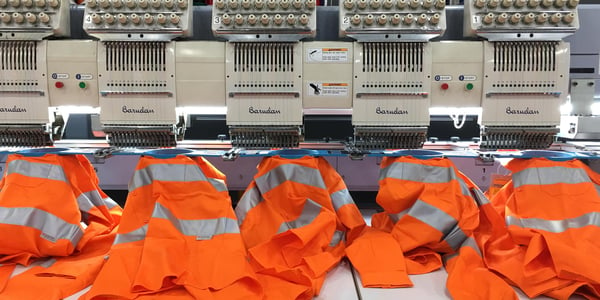
Branding Hi-Visibility Safety Garments
Adding your logo to your workwear is a great way to promote your company and ensure your workers look professional – and it comes with a tax incentive.
Depending on what embellishment technique you use to apply your logo, you may jeopardise the classification of the garment. For example, as Day compliance is dependent on the amount of hi visibility colour meeting 0.2m2 on the front and back, it should be noted that adding a large logo or embellishment to a garment could render it non-compliant. As a general rule of thumb, if a logo takes up less than 10cm x 10cm square in space, it will not affect the compliance of a garment.
Let's break down the different embellishment techniques suitable for hi vis workwear. You might also like to check out our post on the best positions for embellishment and embroidery.
Embroidery
Embroidery offers a durable and hard-wearing option for workwear and one of the most common embellishment techniques used to brand a hi vis garment. Embroidered logos can be positioned on a number of locations on workwear and allow you to reproduce the logo in colour and with accurate detail. Embroidery on wet weather jackets may also impair the water resistant properties of the garment. There are printing alternatives that do not impact the water resistance, such as screen printing and heat transfers.
You can embroider hi-vis polos, hi-vis shirts and overalls, pants, trousers and shorts, hi-vis jackets and vests, hoodies and fleece jumpers, hats, caps and beanies.
Screen printing
Screen printing is a popular, economical and long-lasting solution. However, screen printing may not be suitable for some hi-vis fabrics, particularly if it features treated or inherent properties. With screen printing, each colour in your logo or graphic is broken down into separate screens (much like stencils) and printed in sequence onto the garment. The same design can be reproduced multiple times once the screens are made which makes this an economical option for large quantities, or if you want to print a large logo or graphic.
Heat transfer
This process uses a specialist vinyl which is printed onto and laser cut to create a transfer, which is then applied by a heat press, permanently sealing the design to the garment. A process that Total Uniform Solutions uses is SupaColour, which offers a high level of colour vibrancy and detail in logos and graphics. SupaColour is tested to 50+ domestic washes which is ideal for hi-vis workwear. SupaColour is perfect for branding waterproof clothing, often used on hi-vis workwear. Logos and graphics are typically achieved at low price per application, with minimum set-up required.
Custom Tabs
This is a subtle way of overcoming the personal tax aspect that qualifies a hi-vis garment as a corporate uniform. Best done at the point of manufacture, woven tabs or labels can be added to identify the garment as a uniform, rather than a ‘fringe benefit’ to the employee. Labels must be clearly visible and non-removable and are usually positioned near a seam, pocket or waistband. This can be a good strategy for hi-vis pants when you don't want to add a logo.
In Summary
Standards are living documents and are periodically reviewed and new editions or amendments are published or withdrawn. For more information about Australian workwear standards, speak to your workwear provider.


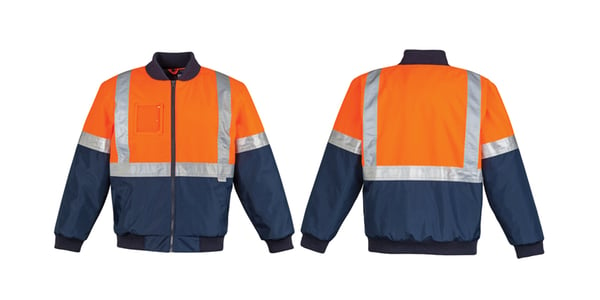

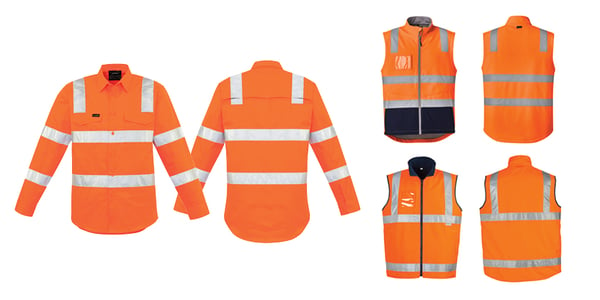
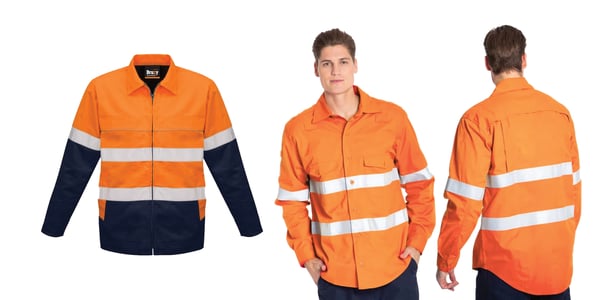
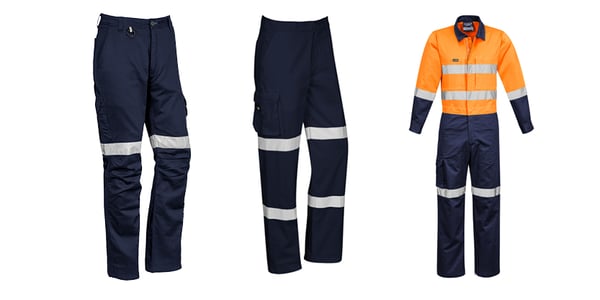 For lower body garment or coveralls, the addition of 50mm hoops at the knee, or the knee and ankle (for biomotion), as required.
For lower body garment or coveralls, the addition of 50mm hoops at the knee, or the knee and ankle (for biomotion), as required.